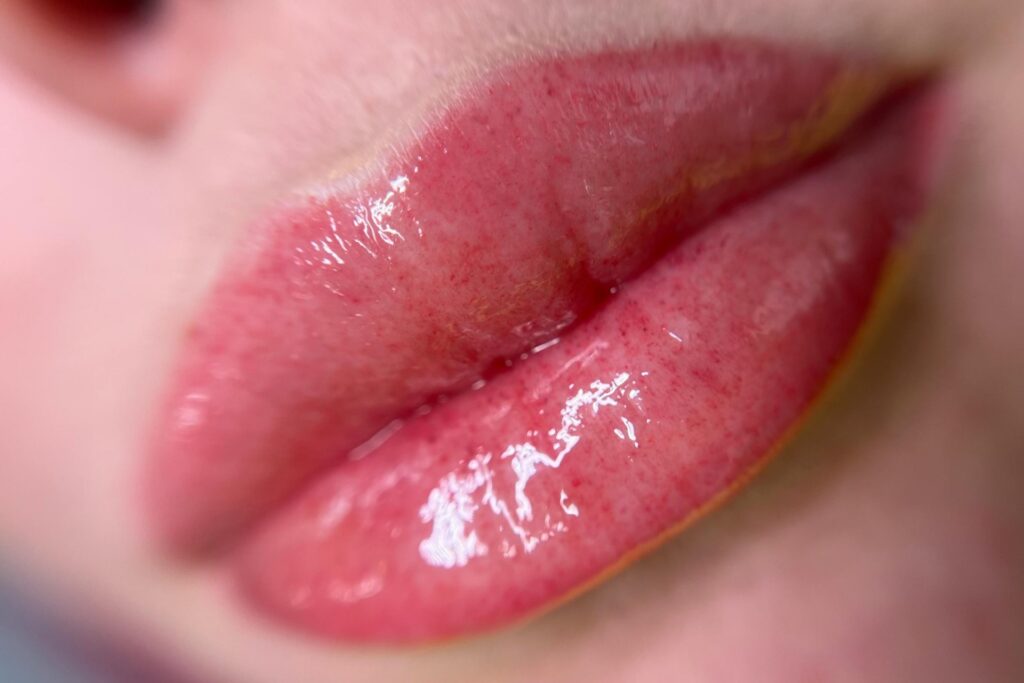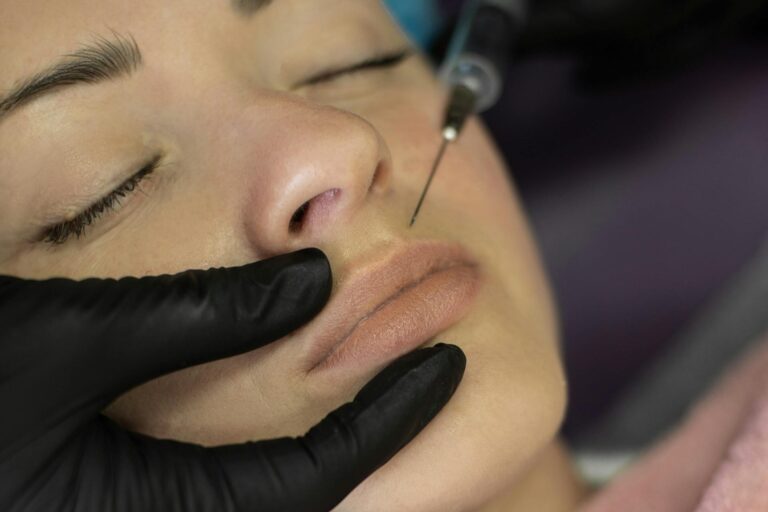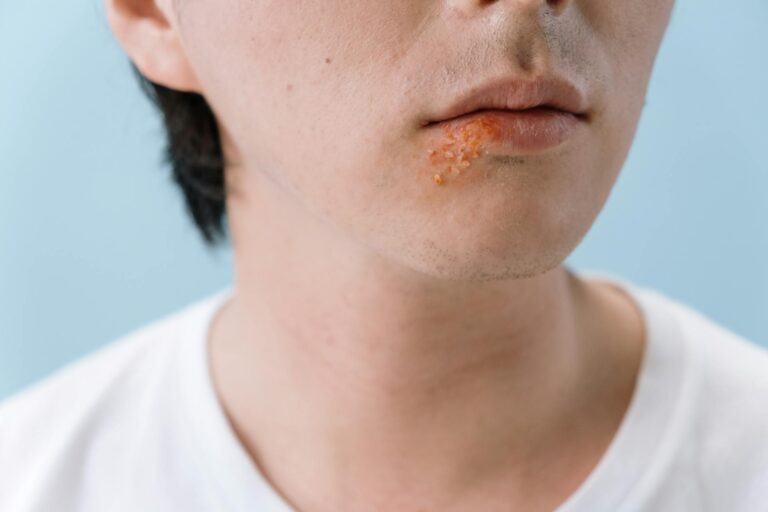
Lip fillers have become increasingly popular as a quick and effective method for enhancing the volume and shape of lips. With a variety of options available, it is important to understand the different lip filler types—ranging from hyaluronic acid to synthetic variations—to make informed decisions about your aesthetic goals.
This guide will explore how these fillers work, as well as their benefits and risks, helping you choose the right option for your needs. You will learn what to expect both during and after treatment, the longevity of the results, and the associated costs for a lip filler procedure.
What Are Lip Fillers?

Lip fillers, often referred to as dermal fillers, have become a popular non-surgical option for enhancing lips. This procedure allows individuals to achieve their desired lip volume, shape, and contour.
As lip filler trends continue to evolve, many people are opting for subtle enhancements that prioritise natural-looking results, aligning with the growing preference for understated beauty. Frequently used in cosmetic treatments, lip fillers enhance facial aesthetics and improve lip definition, offering a pathway to a more youthful and fuller appearance.
This treatment has become a go-to solution for those seeking to increase lip thickness and smoothness without resorting to invasive surgery, making it a staple in modern beauty practices.
What Are the Different Types of Lip Fillers?
There are various types of lip fillers available on the market today, each tailored to meet specific aesthetic desires and patient preferences.
The most common options include hyaluronic acid fillers, renowned for their hydrating and volumising effects. Additionally, collagen fillers stimulate collagen production, while fat transfer fillers use the patient’s own tissue for a more natural approach. There are also synthetic fillers that provide a long-lasting solution.
Popular brands like Juvederm, Restylane, and Allergan offer a range of choices designed for optimal lip enhancement.
1. Hyaluronic Acid Fillers
Hyaluronic acid fillers are among the most popular choices for lip augmentation, renowned for their ability to provide smoothness and a natural appearance to the lips. These fillers function by attracting moisture to the lip area, resulting in a plump and hydrated look that many individuals desire.
Beyond enhancing volume, hyaluronic acid fillers offer several benefits, such as reducing fine lines and improving the overall contour of the lips. Their appeal largely stems from their biocompatibility, which allows for seamless integration with the body’s tissue—an essential factor for achieving effective results.
Patients often notice a significant improvement in their aesthetic appearance, which typically leads to high levels of satisfaction. The effects of these fillers generally last between six months and a year, making them a popular option for those seeking temporary enhancements.
With appropriate care, these treatments can yield favourable outcomes, providing individuals with the confidence boost they desire while ensuring minimal downtime.
2. Collagen Fillers
Collagen fillers have traditionally been a popular choice for enhancing lips, as they are designed to increase lip volume by stimulating collagen production in the skin. By replenishing lost collagen, these fillers help individuals achieve fuller, more youthful-looking lips, which aligns with the aesthetic goals of many patients.
This innovative approach not only enhances the fullness of the lips but also supports the overall structure of the skin, providing a natural-looking plumpness that can enhance one’s features. Unlike hyaluronic acid fillers, which focus mainly on adding volume, collagen fillers promote the body’s inherent healing processes. Many patients appreciate the more gradual and natural changes that these fillers offer.
Additionally, the results from collagen fillers can last longer—typically from six months to a year—when compared to temporary options. This helps to dispel the misconception that collagen fillers are short-lived. By understanding these distinctions, individuals can make informed choices that align with their unique preferences and beauty aspirations.
3. Fat Transfer Fillers
Fat transfer fillers provide a distinctive method for lip enhancement by utilising the patient’s own fat, which is harvested from other areas of their body. This technique not only ensures a high level of tissue compatibility but also delivers a more natural appearance, appealing to those seeking aesthetic improvements.
The procedure starts with a liposuction technique that gently extracts fat, usually sourced from the abdomen or thighs, using a small cannula. After the fat is harvested, it undergoes purification and preparation for injection.
Experienced practitioners employ precise techniques to inject the fat into the lips, skillfully sculpting the desired shape. Although this method often results in long-lasting outcomes, there is a possibility of filler migration, meaning the fat may shift slightly from where it was originally placed.
The benefits of this approach include a reduced risk of allergic reactions and a natural feel, but it is important to consider potential risks such as swelling or bruising.
Recovery time can vary, with most individuals typically able to resume normal activities within a week. This allows them to enjoy fuller, natural-looking lips with minimal downtime.
4. Synthetic Fillers
Synthetic fillers are carefully engineered products specifically designed for lip augmentation, often yielding longer-lasting results compared to their natural alternatives. These fillers can effectively enhance the volume and contour of the lips, but it is essential for potential patients to understand the associated risks and considerations.
Among the various options available, hyaluronic acid fillers are particularly favored for their ability to retain moisture and deliver a fuller appearance. On the other hand, polymethyl methacrylate (PMMA) fillers provide greater structural support for more enduring results.
Each type offers unique advantages:
- Hyaluronic acid provides instant volume that can be reversed if needed.
- Other formulations can stimulate collagen production, delivering a biostimulatory effect.
However, it is important for patients to be aware of possible side effects, which may include swelling, bruising, or allergic reactions. Education on maintenance is crucial, as some individuals may need touch-up treatments to maintain their desired appearance.
This highlights the importance of adhering to post-procedure guidelines to optimise the outcomes of the treatment.
How Do Lip Fillers Work?

Lip fillers operate through a method known as filler injection, in which volumising agents are carefully injected into the lips to enhance their shape, volume, and overall contour. This non-surgical procedure offers immediate results and can be customised to suit each person’s aesthetic preferences and facial symmetry.
The science behind lip fillers involves the use of hyaluronic acid, a naturally occurring substance in the body that helps maintain hydration and plumpness. When injected, these fillers attract water molecules, resulting in a fuller appearance. Skilled aesthetic practitioners utilise various techniques, such as linear threading and cross-hatching, to ensure even distribution and a natural movement of the lips.
A personal consultation is essential, as it provides the practitioner with insight into individual preferences, facial structure, and any concerns. This collaborative approach ultimately ensures that the final outcome aligns perfectly with the client’s vision.
What Are the Benefits of Lip Fillers?
The benefits of lip fillers go beyond just enhancing appearance; they provide a variety of advantages that contribute to facial rejuvenation and boost self-esteem.
Many individuals consider lip fillers to achieve greater lip volume, refine lip contouring, and attain a natural look that is in line with contemporary cosmetic trends.
What Are the Risks of Lip Fillers?
While lip fillers are generally considered safe, it is important for patients to be aware of the potential risks and side effects before undergoing treatment.
Common side effects may include swelling and bruising, and in rare instances, allergic reactions can occur. These factors can impact the overall satisfaction with the lip filler experience.
1. Allergic Reactions
Allergic reactions, while rare, can be a serious side effect associated with lip fillers. These reactions typically occur as a result of the body’s response to the injected materials. It is important to understand the signs and symptoms of an allergic reaction to ensure safety during the lip enhancement process.
Recognising early symptoms, such as swelling, redness, or itching, enables individuals to seek prompt medical attention. To minimise these risks, it is essential for prospective patients to engage in thorough consultations with qualified professionals. These experts can assess individual sensitivities and recommend appropriate products accordingly.
Additionally, educating patients about potential complications—such as the signs of a severe allergic response like difficulty breathing or anaphylaxis—enables them to make informed decisions. This understanding not only enhances safety but also contributes to a more positive experience with cosmetic procedures.
2. Infection
Infection is a potential risk associated with lip filler treatments, as the skin barrier is temporarily compromised during the injection process. If not managed properly, this can lead to complications often described as a lip filler procedure gone wrong.
To minimise this risk, patients should closely follow the specific aftercare instructions provided by their aesthetic practitioners. This includes refraining from touching the treated area with unwashed hands and avoiding strong facial cleansers or exfoliants for at least 48 hours. It is also advisable to delay the application of make-up for a brief period to allow the skin to heal properly.
Additionally, staying hydrated and using gentle, non-irritating products to keep the lips lubricated can support the recovery process. Regular follow-ups with the practitioner are essential for monitoring healing progress and addressing any concerns that may arise, ensuring a smooth recovery and reducing the likelihood of complications.
3. Bruising and Swelling
Bruising and swelling are typical side effects that individuals may experience after receiving lip filler injections, and these usually resolve within a few days. Having a clear understanding of the normal healing process can help set realistic expectations and enhance overall patient satisfaction.
To effectively manage these side effects, it is important for patients to follow the post-treatment care instructions provided by their practitioner. For instance, applying ice packs intermittently during the first 24 hours can significantly reduce swelling and alleviate any discomfort. Additionally, elevating the head while sleeping can minimise fluid retention around the injection sites.
Typically, recovery progresses with minimal discomfort during the first week, and significant improvements are often noticeable by the third or fourth day. Staying hydrated and avoiding strenuous activities can support the body’s healing processes, leading to a smoother and more comfortable recovery period.
How to Choose the Right Lip Filler for You?

Choosing the right lip filler requires a clear understanding of your aesthetic goals, personal preferences, and the various types of fillers available. Key considerations include the desired thickness, smoothness, and longevity of the results, all of which are essential for making an informed decision.
To ensure the best choice, it is advisable to assess your individual preferences and consult with a qualified aesthetic practitioner. These professionals can offer tailored insights into the different brands and types of fillers available on the market, such as hyaluronic acid versus collagen-based options, along with their respective advantages and disadvantages.
Engaging in a comprehensive consultation is vital, as it helps ensure that the filler selected aligns with your specific desires—whether you’re aiming for a subtle plump or a more pronounced volume enhancement. Additionally, understanding the infusion technique and the reputation of the filler brand can significantly influence your satisfaction with the final results.
What to Expect During and After Lip Filler Treatment?
Understanding what to expect during and after lip filler treatment can significantly help patients feel more at ease and prepared for the process.
By familiarising themselves with the journey—from the initial consultation to the appointment procedures and the recovery phase—patients can enhance their overall experience and satisfaction with the treatment.
1. Consultation and Preparation
The consultation and preparation phase plays a crucial role in achieving the desired results in lip filler treatments. During this initial meeting, patients have the opportunity to discuss their aesthetic goals, explore available options, and learn about the different types of fillers on the market.
This phase is not just about answering questions; it also serves as a chance for practitioners to build a trusting relationship with patients. Emphasising safety is paramount, as understanding the potential risks and side effects allows individuals to make informed decisions.
Practitioners should actively listen to patient preferences, as these insights are invaluable in tailoring the procedure to meet each individual’s unique aspirations. It is essential to set realistic expectations regarding the results, ensuring that patients leave the consultation feeling informed and confident in their choices.
This holistic approach ultimately fosters a more satisfying experience and leads to optimal outcomes.
2. Injection Procedure
The injection procedure plays a vital role in the lip filler treatment process. Skilled practitioners employ specific injection techniques to achieve the desired volume and contour of the lips, and this step demands precision to ensure both safety and optimal outcomes.
Typically, the process begins with a comprehensive consultation where the practitioner discusses the patient’s aesthetic goals and any concerns they may have.
During the procedure, the practitioner might utilise techniques such as the ‘serial puncture’ or ‘linear threading’ method.
These approaches facilitate a more even distribution of the filler and help minimise the risk of lumps.
Patients often experience anxiety regarding discomfort; however, most practitioners prioritise pain management. They may apply a topical numbing cream or use fillers that contain lidocaine, a local anaesthetic, to alleviate any potential discomfort.
Throughout the appointment, practitioners aim to create a relaxed atmosphere, reassuring patients that their comfort is a top priority. Ultimately, the goal is to achieve a harmonious and natural-looking enhancement.
3. Recovery and Aftercare
Recovery and aftercare play a vital role in achieving the best results following lip filler treatment. Patients should be aware that bruising and swelling might occur and that adhering to specific aftercare guidelines is essential for promoting healing and maintaining their enhanced appearance.
It is important for individuals to understand that the recovery period can differ from person to person, typically lasting anywhere from a few days to a week, depending on individual circumstances and the extent of the procedure.
Aftercare should involve avoiding strenuous activities and excessive sun exposure, as well as refraining from blood-thinning medications, which can worsen bruising.
Effectively managing side effects like mild swelling or tenderness is also crucial. Applying ice packs can be an effective way to alleviate discomfort.
By diligently following the post-treatment instructions provided, individuals can enhance their healing process, reduce the risk of complications, and ultimately achieve greater satisfaction with their lip enhancements.
How Long Do Lip Fillers Last?
The longevity of lip fillers can vary depending on several factors, including the type of filler used, individual metabolism, and maintenance practices. Typically, most lip fillers offer results that last somewhere between six months and a year. However, lifestyle choices and the technique used during the injection can also influence this duration.
Patients often notice that aspects such as hydration levels, diet, and skincare routines can significantly affect how long the results last. Additionally, the unique physiological characteristics of each individual, such as skin elasticity and age, play crucial roles in how well the fillers connect with the underlying tissues.
Regular touch-up treatments can not only extend the aesthetic appeal of lip fillers but also assist in maintaining symmetry and volume. By adhering to a recommended maintenance schedule, individuals can help ensure that their lip enhancements remain fresh and vibrant, contributing to a consistently youthful appearance.
How Much Do Lip Fillers Cost?

The cost of lip fillers can vary significantly due to several factors, including the type of filler used, the practitioner’s expertise, and the geographical location of the clinic. Individuals considering aesthetic treatments should be prepared for a wide range of prices and should take into account the value of quality care when making their decisions.
Typically, lip fillers can range from £500 to £2,000 per session, with hyaluronic acid options often being among the most common and cost-effective. Pricing can be influenced by factors such as the brand of the product, the volume used, and the complexity of the treatment.
It is essential for individuals to recognise the importance of choosing a qualified professional for these procedures; the results of a minimally invasive treatment can vary greatly depending on the practitioner’s skill and experience.
By prioritising education and seeking out expertise, patients can better ensure that they achieve the desired results safely and effectively.
Frequently Asked Questions
What are the different lip filler types available?
There are several types of lip fillers available, including hyaluronic acid fillers, collagen fillers, and fat transfer fillers.
What is the most common type of lip filler?
The most common type of lip filler is hyaluronic acid fillers, which are temporary and can last up to 6-12 months.
What is the difference between hyaluronic acid fillers and collagen fillers?
Hyaluronic acid fillers are made from a substance that is naturally found in the body, while collagen fillers are made from animal-derived collagen.
How long do lip fillers typically last?
The duration of lip fillers varies depending on the type used, but most fillers last between 6-12 months before a touch-up is needed.
Are there any risks or side effects associated with lip fillers?
As with any cosmetic procedure, there are potential risks and side effects associated with lip fillers, such as bruising, swelling, and infection. It is important to consult with a qualified and experienced provider to minimise these risks.
How do I know which type of lip filler is right for me?
The type of lip filler that is right for you will depend on your individual goals, preferences, and medical history. It is best to consult with a professional who can assess your specific needs and recommend the most suitable filler for you.






